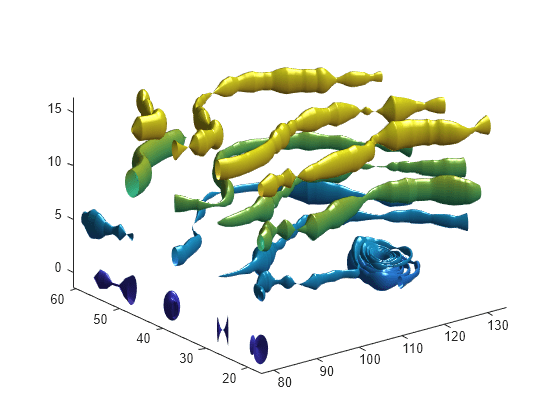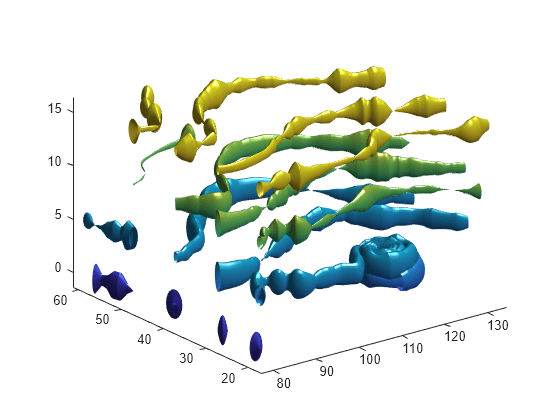streamtube
创建三维流管图
语法
streamtube(X,Y,Z,U,V,W,startx,starty,startz)
streamtube(U,V,W,startx,starty,startz)
streamtube(vertices,X,Y,Z,divergence)
streamtube(vertices,divergence)
streamtube(vertices,width)
streamtube(vertices)
streamtube(...,[scale n])
streamtube(ax,...)
h = streamtube(...)
说明
streamtube(X,Y,Z,U,V,W,startx,starty,startz) 从向量三维体数据 U、V 和 W 绘制流管。
数组 X、Y 和 Z 用于定义 U、V 和 W 的坐标,它们必须是单调的,无需间距均匀。X、Y 和 Z 必须具有相同数量的元素,就像由 meshgrid 生成一样。
startx、starty 和 startz 定义位于管道中心的流线图的起始位置。
管道的宽度与向量场的归一化散度成比例。
streamtube(U,V,W,startx,starty,startz) 假定 X、Y 和 Z 由以下表达式确定
[X,Y,Z] = meshgrid(1:n,1:m,1:p)
其中 [m,n,p] = size(U)。
streamtube(vertices,X,Y,Z,divergence) 使用预先计算的流线图顶点和散度。vertices 是流线图顶点的元胞数组(就像由 stream3 生成一样)。X、Y、Z 和 divergence 都是三维数组。
streamtube(vertices,divergence) 假定 X、Y 和 Z 由以下表达式确定
[X,Y,Z] = meshgrid(1:n,1:m,1:p)
其中 [m,n,p] = size(divergence)。
streamtube(vertices,width) 在向量元胞数组 width 中指定管道的宽度。vertices 和 width 的每个对应元素的大小必须相同。width 也可以是标量,用于为所有流管的宽度指定单个值。
streamtube(vertices) 自动选择宽度。
streamtube(...,[scale n]) 按照 scale 缩放管道的宽度。默认值为 scale = 1。创建流管时,使用开始点或散度、指定 scale = 0 将禁止自动缩放。n 是指沿管道的周长分布的点数。默认值为 n = 20。
streamtube(ax,...) 将图形绘制到 ax 坐标区对象中,而不是当前坐标区对象 (gca) 中。
h = streamtube(...) 返回用于绘制流管图的 surface 对象(每个起点一个)的向量。
示例
扩展功能
版本历史记录
在 R2006a 之前推出


